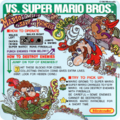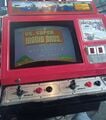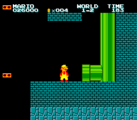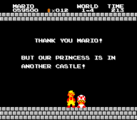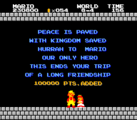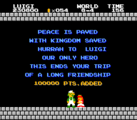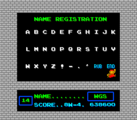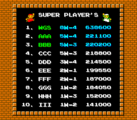VS. Super Mario Bros.: Difference between revisions
(→Differences: Details of difference from NES version, and Lost Level imports) |
No edit summary Tag: Mobile edit |
||
| (222 intermediate revisions by 94 users not shown) | |||
| Line 1: | Line 1: | ||
[[ | {{italic title}} | ||
''''' | {{game infobox | ||
|image=[[File:VSSMB Title Screen.png|256px]]<br>The title screen of the game | |||
|developer=[[Nintendo Entertainment Analysis and Development|Nintendo EAD]] | |||
|publisher=[[Nintendo]]<br>[[HAMSTER Corporation|HAMSTER]] (''[[Arcade Archives]]'') | |||
|platforms=[[VS. System]]<br>[[Nintendo Switch]] (''Arcade Archives'') | |||
|release='''VS. System:'''<br>{{flag list|USA|March 7, 1986<ref name=Cash>[https://archive.org/details/cashbox49unse_42/page/37/mode/1up Cash Box April 19, 1986 issue]</ref>}} '''Nintendo Switch (''Arcade Archives''):'''<br>{{flag list|Japan|December 22, 2017<ref name=JPrelease>{{Cite|date=December 13, 2017|url=https://web.archive.org/web/20171216092849/http://www.japanesenintendo.com/post/168503126344|title=VS. Super Mario Bros. releasing next week|publisher=Nintendo Japan|accessdate=December 14, 2017}}</ref>|USA|December 22, 2017<ref name=USArelease>{{Cite|url=https://www.nintendo.com/us/store/products/arcade-archives-vs-super-mario-bros-switch/?origin=serp_auto|title=Arcade Archives VS. SUPER MARIO BROS. - Nintendo|publisher=Nintendo of America|language=en-us}}</ref>|Europe|December 22, 2017|Australia|December 23, 2017}} | |||
|languages={{languages|en_us=y}} | |||
|genre=2D platformer | |||
|modes=Multiplayer (up to two players, alternating) | |||
|cabinet=VS. UniSystem, VS. DualSystem, and VS. Table | |||
|ratings={{ratings|acb=g|cero=a|esrb=e|pegi=3|rars=16+}} | |||
|format={{format|arcade=1|switchdl=1}} | |||
|input={{input|arcade=1|joy-con=1|joy-con-horizontal=1|switchpro=1}} | |||
}} | |||
'''''VS. Super Mario Bros.''''' is a two-player [[VS. System]] version of ''[[Super Mario Bros.]]'' that was released in [[List of games by date#1986|1986]]. | |||
==Story== | ==Story== | ||
[[Mario]] | The plot is the same as in the original ''Super Mario Bros.'', featuring [[Mario]] and [[Luigi]] (second player only) setting out on a quest to free [[Princess Peach|Princess Toadstool]] from the evil [[Bowser]] and restore the fallen [[Mushroom Kingdom|kingdom]] of the [[Toad (species)|Mushroom People]]. | ||
==Differences== | ==Differences== | ||
This game | This game has higher gameplay difficulty than the original ''Super Mario Bros.'', with fewer [[Warp Zone|warp zone]]s and power-ups, and more enemies. Six new levels were created for the game,<ref>Nintendo (December 7, 2010), [https://youtu.be/DNa0M1gymgA?t=3m47s Super Mario Bros. 25th Anniversary - Interview with Shigeru Miyamoto #2]. ''YouTube''. Retrieved December 21, 2015.</ref> all of which were reused in ''[[Super Mario Bros.: The Lost Levels]]''. | ||
Fire Mario is now more yellowish, much like his sprite in ''[[Super Mario Bros. 3]]'', instead of being colored red and white. | |||
The original | ===Detailed set of level differences=== | ||
The original version of ''Super Mario Bros.'' has some levels repeat, with an easier version with some obstacles removed ([[Fire Bar|Fire-Bar]]s in the castle, fewer enemies, etc) earlier on, and then a later "full" version, e.g. 1-3 is the easier version of 5-3; 1-4 is the easier version of 6-4; 2-2/2-3 are the easier version(s) of 7-2/7-3; and 2-4 is the easier version of 5-4. | |||
In the arcade version, | In the arcade version, most of the "easier versions" (all except 1-3) are replaced by the "harder version" to make way for new levels. | ||
The following table summarizes the changes. Unlisted levels are mostly the same as the corresponding level in ''Super Mario Bros.'', but with minor difficulty increases. Various [[? Block|?]]s, especially those that contain power-ups, are often either moved to much harder-to-reach places, or even removed altogether, or the power-ups are replaced with [[coin]]s. Many bottomless pits and more enemies have been added as well. | |||
{|class="wikitable sortable" | |||
|- | |||
!''VS.'' level!!Corresponding level!!Description | |||
|- | |||
|1-2||[[World 1-2 (Super Mario Bros.)|''Super Mario Bros.'' 1-2]]||Some [[Brick Block|brick]]s above the end [[Warp Pipe|pipe]] have been removed to prevent use of the [[Minus World]] glitch, though all of the pipes are still present and it is still possible to perform the glitch. However, the Minus World does still exist in this game, though it is now based on the hidden underwater section of Worlds 5-2 and 6-2 from the original version, respectively. | |||
|- | |||
|1-3||[[World 1-3 (Super Mario Bros.)|''Super Mario Bros.'' 1-3]]||The ground before the final staircase has been removed. | |||
|- | |||
|1-4||[[World 1-4 (Super Mario Bros.: The Lost Levels)|''The Lost Levels'' 1-4]]||Resembles World 1-4 from the original game, but with more lava pits and Fire-Bars. | |||
|- | |||
|2-2||[[World 7-2 (Super Mario Bros.)|''Super Mario Bros.'' 7-2]]||Replaced with the harder variation from the original game, with a 350-second timer. | |||
|- | |||
|2-3||[[World 7-3 (Super Mario Bros.)|''Super Mario Bros.'' 7-3]]||Replaced with the harder variation from the original game. | |||
|- | |||
|2-4||[[World 6-4 (Super Mario Bros.)|''Super Mario Bros.'' 6-4]]||Replaced with a harder level from the original game. | |||
|- | |||
|3-1||[[World 3-1 (Super Mario Bros.)|''Super Mario Bros.'' 3-1]]||The [[Koopa Troopa]]s on the final staircase have been replaced with [[Goomba|Little Goomba]]s to prevent use of the infinite 1-Up exploit.<ref name="BBH's Waste of Bandwidth">https://web.archive.org/web/20170707123117/http://bbh.marpirc.net/skatekid/</ref> | |||
|- | |||
|3-2||[[World 2-2 (Super Mario Bros.: The Lost Levels)|''The Lost Levels'' 2-2]]||Similar to [[World 3-2 (Super Mario Bros.)|3-2 from ''Super Mario Bros.'']], but with more obstacles and a large gap requiring use of [[Hidden Block]]s and a high floating pipe to cross. | |||
|- | |||
|4-1||[[World 4-1 (Super Mario Bros.)|''Super Mario Bros.'' 4-1]]||The timer counts down from 350 seconds. | |||
|- | |||
|4-2||[[World 4-2 (Super Mario Bros.)|''Super Mario Bros.'' 4-2]]||The level is largely the same, but the pipes to Worlds 7 and 8 have been removed (the player can now only warp to World 6, meaning that there is no way to skip to the final world). Additionally, a Buzzy Beetle seen descending a staircase is replaced with a Little Goomba to prevent the infinite 1-Up trick. | |||
|- | |||
|4-4||[[World 5-4 (Super Mario Bros.)|''Super Mario Bros.'' 5-4]]||4-4 and 5-4 have been switched, but are mostly the same otherwise. | |||
|- | |||
|5-3||[[World 6-3 (Super Mario Bros.)|''Super Mario Bros.'' 6-3]]||This is now a normal-colored level (much like in ''[[Super Mario All-Stars]]'') instead of the gray night as seen in ''Super Mario Bros.'' | |||
|- | |||
|5-4||[[World 4-4 (Super Mario Bros.)|''Super Mario Bros.'' 4-4]]||4-4 and 5-4 have been switched, but are mostly the same otherwise. | |||
|- | |||
|6-1||[[World 6-1 (Super Mario Bros.)|''Super Mario Bros.'' 6-1]]||The timer counts down from 350 seconds. | |||
|- | |||
|6-3||[[World 4-3 (Super Mario Bros.: The Lost Levels)|''The Lost Levels'' 4-3]]||Some extremely long jumps to platforms, including one that requires a bounce off of a [[Koopa Paratroopa]]. This is even harder to pull off than in ''The Lost Levels'' because Mario does not get nearly as much extra height from a bounce as he does in that game, requiring near-perfect accuracy. Due to World 6-3 being predominantly gray, this entire level has been recolored gray. | |||
|- | |||
|6-4||[[World 5-4 (Super Mario Bros.: The Lost Levels)|''The Lost Levels'' 5-4]]||Lots of long, hard jumps and some tricky small ones, plus an extra long Fire-Bar only seen in [[World 5-4 (Super Mario Bros.)|5-4 of ''Super Mario Bros.'']] | |||
|- | |||
|7-1||[[World 7-1 (Super Mario Bros.)|''Super Mario Bros.'' 7-1]]||Much like World 3-1, the [[Buzzy Beetle]] on the end staircase before the [[Goal Pole|flagpole]] is replaced with a Little Goomba, again to prevent the infinite 1-Up trick, and the timer lasts for 350 seconds. | |||
|- | |||
|7-2||[[World 6-2 (Super Mario Bros.: The Lost Levels)|''The Lost Levels'' 6-2]]||A harder and longer version of [[World 7-2 (Super Mario Bros.)|7-2 of ''Super Mario Bros.'']], with very little floor and stretches of low-hanging reef. | |||
|- | |||
|7-3||[[World 6-3 (Super Mario Bros.: The Lost Levels)|''The Lost Levels'' 6-3]]||An extra-long bridge with lots of gaps and many more [[Cheep Cheep|Cheep-cheep]]s and Koopa Paratroopas than [[World 7-3 (Super Mario Bros.)|7-3 of ''Super Mario Bros.'']] | |||
|- | |||
|7-4||[[World 7-4 (Super Mario Bros.)|''Super Mario Bros.'' 7-4]]||The layout is largely the same, but the solution to the maze is slightly different.<ref name="BBH's Waste of Bandwidth"></ref> | |||
|- | |||
|8-1||[[World 8-1 (Super Mario Bros.)|''Super Mario Bros.'' 8-1]]||The timer counts down from 350 seconds. | |||
|- | |||
|8-2||[[World 8-2 (Super Mario Bros.)|''Super Mario Bros.'' 8-2]]||The timer counts down from 350 seconds. | |||
|- | |||
|8-4||[[World 8-4 (Super Mario Bros.)|''Super Mario Bros.'' 8-4]]||Same general layout, but with the Hidden Block needed to reach a necessary pipe moved one space higher, and the Bowser bridge now has bricks above, making it more narrow. | |||
|} | |||
The hidden [[1-Up Mushroom|1 up Mushroom]]s in 2-1, 4-1, 6-1, and 8-1 have been removed. The ones in 3-1, 5-1, and 7-1 are only available if enough coins are collected in one of two previous -3 levels: | |||
*World 3-1: Must collect at least 21 coins in World 1-3 or all 35 coins in World 2-3 | |||
*World 5-1: Must collect all 22 coins in World 3-3 or all 27 coins in World 4-3 | |||
*World 7-1: Must collect at least 23 coins in World 5-3 or at least 24 coins in World 6-3 | |||
Depending on operator settings, the player may now start with two lives instead of three and the [[Time Limit|timer]] may be set to run faster than the NES version's timer did. Worlds 2-2, 4-1, 6-1, 7-1, 8-1, and 8-2 have a 350-second timer. The coin counter now has three digits instead of two, meaning that Mario/Luigi may have to collect more than 100 coins (can be set to 100, 150, 200, or 250 by the operator) to earn an extra life. After a game over, depending on operator settings, the player may continue with four lives instead of three. Additionally, as mentioned above, the infinite lives trick has been removed from certain levels that have either Koopas or Buzzy Beetles descending staircases, by having them all be replaced with Little Goombas, although some levels still feature Koopa Paratroopas descending staircases and were not replaced with Little Goombas, allowing the player to circumvent this issue. | |||
The ending is identical to that which would later appear in ''The Lost Levels'', including awarding 100,000 points for each life the player has left, but the "[[Ending (Super Mario Bros.)|Ending]]" theme uses the original ''Super Mario Bros.''{{'}}s instrumentation. In the original game, the second part was removed to make for a looping song due to storage limitations.<ref>shmuplations, "[https://shmuplations.com/kojikondo/ Koji Kondo – 2001 Composer Interview]".</ref> After the song ends, the game is over and the player can enter their initials. Additionally, there is no [[Warp Door|door]] after the final Bowser like in ''The Lost Levels'', and the princess is still in the area behind him, making the ending cutscene more jarring. Finally, there is no [[Hard Mode]] after completing the game. | |||
==Production and release== | |||
: | ''VS. Super Mario Bros.'' was to be called '''''VS. Mario's Adventure'''''. The only remnant of this earlier title is an arcade flyer with a trademarked name.<ref>[https://flyers.arcade-museum.com/?page=thumbs&db=videodb&id=6009 VS. Mario's Adventure arcade flyers]</ref> | ||
The game made its debut at the American Coin Machine Exposition held in Chicago from March 7-9, 1986.<ref name=Cash/> The physical arcade version was not officially released in Japan despite its high demand,<ref>[https://onitama.tv/gamemachine/pdf/19860301p.pdf#page=13 "Coin-Op "Super Mario" Will Shop To Overseas"]. Game Machine. Amusement Press. Published March 1, 1986.</ref><ref>[https://archive.org/details/play-meter-volume-12-number-5-april-1986-600DPI/Play%20Meter%20-%20Volume%2012%2C%20Number%205%20-%20April%201986%20%28Compressed%29/page/9/mode/1up Play Meter - Volume 12, Number 5 - April 1986]</ref> and Japanese arcade operators found ways to get the game in their arcades regardless.<ref>[https://onitama.tv/gamemachine/pdf/19860501p.pdf#page=11 "Jaleco Ships New Game For "VS. System"" (Paragraph 5)]. Game Machine. Amusement Press. Published May 1, 1986.</ref><ref>[https://onitama.tv/gamemachine/pdf/19870615p.pdf#page=12 "Namco's "Family Stadium" Has Enjoyed Popularity" (Paragraphs 9-11)]. Game Machine. Amusement Press. Published June 15, 1987.</ref> | |||
==''Arcade Archives'' port== | |||
In the September 2017 Nintendo Direct, Nintendo announced '''''Arcade Archives: VS. Super Mario Bros.''''', a re-release of ''VS. Super Mario Bros.'' for the [[Nintendo Switch]] as part of [[HAMSTER Corporation]]'s ''[[Arcade Archives]]'' series. This time, two detached [[Nintendo Switch#Joy-Con|Joy-Con]] are used to play with two players.<ref>GameXplain. (September 13, 2017). [https://youtu.be/fqq6rAFwlns Arcade Archives for Nintendo Switch Announced (Mario Bros. more)]. ''YouTube''. Retrieved September 13, 2017.</ref> It was released in Japan,<ref name=JPrelease/> the Americas<ref name=USArelease/> and Europe on December 22, 2017, and in Australia on December 23, 2017. | |||
==Media== | |||
{{media table | |||
|file=VSSMB Ending.oga | |||
|title=Ending | |||
|length=0:30 | |||
}} | |||
==Gallery== | |||
<gallery> | |||
SMBVS Flyer.jpg|''VS. Mario's Adventure'' arcade flyer | |||
VSSMB Alternate Flyer.jpg|Another flyer | |||
VSSMB Flyer back.jpg|Back of the flyer | |||
VsSuperMarioArt.png|Instructional image for the game | |||
VS SMB Marquee.jpg|Arcade marquee for the game | |||
VS Super Mario Bros Arcade Machine.jpg|VS. Table cabinet | |||
VSSuperMarioBrosUpright.jpg|VS. UniSystem cabinet | |||
VS._SMB_NinSwitch GameIcon.jpg|HOME Menu icon of the Nintendo Switch game version | |||
</gallery> | |||
== | ===Screenshots=== | ||
<gallery widths=150> | |||
VSSMB World 1-1.png | |||
VSSMB World 1-2 Screenshot.png | |||
VSSMB World 1-4 Screenshot.png | |||
VSSMB World 8-4 Screenshot.png | |||
VSSMB World 8-4 Luigi Screenshot.png | |||
VSSMB Name Registration Screenshot.png | |||
VSSMB Super Players Screenshot.png | |||
</gallery> | |||
== | ==Trivia== | ||
*The game contains a rearrangement of the original [[Ground Theme (Super Mario Bros.)|''Super Mario Bros.'' ground theme]], which is played during Name Registration on the rankings list. This song was rearranged as the world select theme that appears in the extra mode of the ''[[Super Mario Bros. 3]]'' subgame in ''[[Super Mario Advance 4: Super Mario Bros. 3|Super Mario Advance 4]]'', re-used as a bonus stage song in the ''[[Super Mario Maker]]'' series for ''Super Mario Bros.'' style, and is incorporated as part of the Sky music for ''[[Super Mario Maker 2]]'' in the ''Super Mario Bros.'' style. A version of this with different instrumentation also appears in ''[[Super Mario Bros.: Peach-hime Kyūshutsu Dai Sakusen!]]'', a Japan-only film that was released a few months after ''VS. Super Mario Bros.'' | |||
==References== | |||
{{NIWA|StrategyWiki=Vs. Super Mario Bros.}} | |||
<references/> | |||
</ | |||
{{Super Mario games}} | |||
{{Arcade}} | {{Arcade}} | ||
[[Category:Mario Games]] | {{Switch}} | ||
[[Category:Arcade | [[Category:Super Mario Bros.|*]] | ||
[[Category:Games]] | |||
[[Category:Arcade games]] | |||
[[Category:1986 games]] | [[Category:1986 games]] | ||
[[Category:Platforming | [[Category:Platforming games]] | ||
[[Category: | [[Category:Reissues]] | ||
[[it:Vs. Super Mario Bros.]] | |||
[[de:Vs. Super Mario Bros.]] | |||
Latest revision as of 11:52, November 8, 2024
| VS. Super Mario Bros. | |||||||||||
|---|---|---|---|---|---|---|---|---|---|---|---|
 The title screen of the game | |||||||||||
| Developer | Nintendo EAD | ||||||||||
| Publisher | Nintendo HAMSTER (Arcade Archives) | ||||||||||
| Platform(s) | VS. System Nintendo Switch (Arcade Archives) | ||||||||||
| Release date | VS. System: Nintendo Switch (Arcade Archives): | ||||||||||
| Language(s) | English (United States) | ||||||||||
| Genre | 2D platformer | ||||||||||
| Rating(s) |
| ||||||||||
| Mode(s) | Multiplayer (up to two players, alternating) | ||||||||||
| Format | Arcade:
Built-in Nintendo Switch: | ||||||||||
| Cabinet | VS. UniSystem, VS. DualSystem, and VS. Table | ||||||||||
| Input | Arcade: Joystick Nintendo Switch: | ||||||||||
VS. Super Mario Bros. is a two-player VS. System version of Super Mario Bros. that was released in 1986.
Story[edit]
The plot is the same as in the original Super Mario Bros., featuring Mario and Luigi (second player only) setting out on a quest to free Princess Toadstool from the evil Bowser and restore the fallen kingdom of the Mushroom People.
Differences[edit]
This game has higher gameplay difficulty than the original Super Mario Bros., with fewer warp zones and power-ups, and more enemies. Six new levels were created for the game,[4] all of which were reused in Super Mario Bros.: The Lost Levels.
Fire Mario is now more yellowish, much like his sprite in Super Mario Bros. 3, instead of being colored red and white.
Detailed set of level differences[edit]
The original version of Super Mario Bros. has some levels repeat, with an easier version with some obstacles removed (Fire-Bars in the castle, fewer enemies, etc) earlier on, and then a later "full" version, e.g. 1-3 is the easier version of 5-3; 1-4 is the easier version of 6-4; 2-2/2-3 are the easier version(s) of 7-2/7-3; and 2-4 is the easier version of 5-4.
In the arcade version, most of the "easier versions" (all except 1-3) are replaced by the "harder version" to make way for new levels.
The following table summarizes the changes. Unlisted levels are mostly the same as the corresponding level in Super Mario Bros., but with minor difficulty increases. Various ?s, especially those that contain power-ups, are often either moved to much harder-to-reach places, or even removed altogether, or the power-ups are replaced with coins. Many bottomless pits and more enemies have been added as well.
| VS. level | Corresponding level | Description |
|---|---|---|
| 1-2 | Super Mario Bros. 1-2 | Some bricks above the end pipe have been removed to prevent use of the Minus World glitch, though all of the pipes are still present and it is still possible to perform the glitch. However, the Minus World does still exist in this game, though it is now based on the hidden underwater section of Worlds 5-2 and 6-2 from the original version, respectively. |
| 1-3 | Super Mario Bros. 1-3 | The ground before the final staircase has been removed. |
| 1-4 | The Lost Levels 1-4 | Resembles World 1-4 from the original game, but with more lava pits and Fire-Bars. |
| 2-2 | Super Mario Bros. 7-2 | Replaced with the harder variation from the original game, with a 350-second timer. |
| 2-3 | Super Mario Bros. 7-3 | Replaced with the harder variation from the original game. |
| 2-4 | Super Mario Bros. 6-4 | Replaced with a harder level from the original game. |
| 3-1 | Super Mario Bros. 3-1 | The Koopa Troopas on the final staircase have been replaced with Little Goombas to prevent use of the infinite 1-Up exploit.[5] |
| 3-2 | The Lost Levels 2-2 | Similar to 3-2 from Super Mario Bros., but with more obstacles and a large gap requiring use of Hidden Blocks and a high floating pipe to cross. |
| 4-1 | Super Mario Bros. 4-1 | The timer counts down from 350 seconds. |
| 4-2 | Super Mario Bros. 4-2 | The level is largely the same, but the pipes to Worlds 7 and 8 have been removed (the player can now only warp to World 6, meaning that there is no way to skip to the final world). Additionally, a Buzzy Beetle seen descending a staircase is replaced with a Little Goomba to prevent the infinite 1-Up trick. |
| 4-4 | Super Mario Bros. 5-4 | 4-4 and 5-4 have been switched, but are mostly the same otherwise. |
| 5-3 | Super Mario Bros. 6-3 | This is now a normal-colored level (much like in Super Mario All-Stars) instead of the gray night as seen in Super Mario Bros. |
| 5-4 | Super Mario Bros. 4-4 | 4-4 and 5-4 have been switched, but are mostly the same otherwise. |
| 6-1 | Super Mario Bros. 6-1 | The timer counts down from 350 seconds. |
| 6-3 | The Lost Levels 4-3 | Some extremely long jumps to platforms, including one that requires a bounce off of a Koopa Paratroopa. This is even harder to pull off than in The Lost Levels because Mario does not get nearly as much extra height from a bounce as he does in that game, requiring near-perfect accuracy. Due to World 6-3 being predominantly gray, this entire level has been recolored gray. |
| 6-4 | The Lost Levels 5-4 | Lots of long, hard jumps and some tricky small ones, plus an extra long Fire-Bar only seen in 5-4 of Super Mario Bros. |
| 7-1 | Super Mario Bros. 7-1 | Much like World 3-1, the Buzzy Beetle on the end staircase before the flagpole is replaced with a Little Goomba, again to prevent the infinite 1-Up trick, and the timer lasts for 350 seconds. |
| 7-2 | The Lost Levels 6-2 | A harder and longer version of 7-2 of Super Mario Bros., with very little floor and stretches of low-hanging reef. |
| 7-3 | The Lost Levels 6-3 | An extra-long bridge with lots of gaps and many more Cheep-cheeps and Koopa Paratroopas than 7-3 of Super Mario Bros. |
| 7-4 | Super Mario Bros. 7-4 | The layout is largely the same, but the solution to the maze is slightly different.[5] |
| 8-1 | Super Mario Bros. 8-1 | The timer counts down from 350 seconds. |
| 8-2 | Super Mario Bros. 8-2 | The timer counts down from 350 seconds. |
| 8-4 | Super Mario Bros. 8-4 | Same general layout, but with the Hidden Block needed to reach a necessary pipe moved one space higher, and the Bowser bridge now has bricks above, making it more narrow. |
The hidden 1 up Mushrooms in 2-1, 4-1, 6-1, and 8-1 have been removed. The ones in 3-1, 5-1, and 7-1 are only available if enough coins are collected in one of two previous -3 levels:
- World 3-1: Must collect at least 21 coins in World 1-3 or all 35 coins in World 2-3
- World 5-1: Must collect all 22 coins in World 3-3 or all 27 coins in World 4-3
- World 7-1: Must collect at least 23 coins in World 5-3 or at least 24 coins in World 6-3
Depending on operator settings, the player may now start with two lives instead of three and the timer may be set to run faster than the NES version's timer did. Worlds 2-2, 4-1, 6-1, 7-1, 8-1, and 8-2 have a 350-second timer. The coin counter now has three digits instead of two, meaning that Mario/Luigi may have to collect more than 100 coins (can be set to 100, 150, 200, or 250 by the operator) to earn an extra life. After a game over, depending on operator settings, the player may continue with four lives instead of three. Additionally, as mentioned above, the infinite lives trick has been removed from certain levels that have either Koopas or Buzzy Beetles descending staircases, by having them all be replaced with Little Goombas, although some levels still feature Koopa Paratroopas descending staircases and were not replaced with Little Goombas, allowing the player to circumvent this issue.
The ending is identical to that which would later appear in The Lost Levels, including awarding 100,000 points for each life the player has left, but the "Ending" theme uses the original Super Mario Bros.'s instrumentation. In the original game, the second part was removed to make for a looping song due to storage limitations.[6] After the song ends, the game is over and the player can enter their initials. Additionally, there is no door after the final Bowser like in The Lost Levels, and the princess is still in the area behind him, making the ending cutscene more jarring. Finally, there is no Hard Mode after completing the game.
Production and release[edit]
VS. Super Mario Bros. was to be called VS. Mario's Adventure. The only remnant of this earlier title is an arcade flyer with a trademarked name.[7]
The game made its debut at the American Coin Machine Exposition held in Chicago from March 7-9, 1986.[1] The physical arcade version was not officially released in Japan despite its high demand,[8][9] and Japanese arcade operators found ways to get the game in their arcades regardless.[10][11]
Arcade Archives port[edit]
In the September 2017 Nintendo Direct, Nintendo announced Arcade Archives: VS. Super Mario Bros., a re-release of VS. Super Mario Bros. for the Nintendo Switch as part of HAMSTER Corporation's Arcade Archives series. This time, two detached Joy-Con are used to play with two players.[12] It was released in Japan,[2] the Americas[3] and Europe on December 22, 2017, and in Australia on December 23, 2017.
Media[edit]
| File info 0:30 |
Gallery[edit]
Screenshots[edit]
Trivia[edit]
- The game contains a rearrangement of the original Super Mario Bros. ground theme, which is played during Name Registration on the rankings list. This song was rearranged as the world select theme that appears in the extra mode of the Super Mario Bros. 3 subgame in Super Mario Advance 4, re-used as a bonus stage song in the Super Mario Maker series for Super Mario Bros. style, and is incorporated as part of the Sky music for Super Mario Maker 2 in the Super Mario Bros. style. A version of this with different instrumentation also appears in Super Mario Bros.: Peach-hime Kyūshutsu Dai Sakusen!, a Japan-only film that was released a few months after VS. Super Mario Bros.
References[edit]
- ^ a b Cash Box April 19, 1986 issue
- ^ a b December 13, 2017. VS. Super Mario Bros. releasing next week. Nintendo Japan. Retrieved December 14, 2017.
- ^ a b Arcade Archives VS. SUPER MARIO BROS. - Nintendo. Nintendo of America (American English).
- ^ Nintendo (December 7, 2010), Super Mario Bros. 25th Anniversary - Interview with Shigeru Miyamoto #2. YouTube. Retrieved December 21, 2015.
- ^ a b https://web.archive.org/web/20170707123117/http://bbh.marpirc.net/skatekid/
- ^ shmuplations, "Koji Kondo – 2001 Composer Interview".
- ^ VS. Mario's Adventure arcade flyers
- ^ "Coin-Op "Super Mario" Will Shop To Overseas". Game Machine. Amusement Press. Published March 1, 1986.
- ^ Play Meter - Volume 12, Number 5 - April 1986
- ^ "Jaleco Ships New Game For "VS. System"" (Paragraph 5). Game Machine. Amusement Press. Published May 1, 1986.
- ^ "Namco's "Family Stadium" Has Enjoyed Popularity" (Paragraphs 9-11). Game Machine. Amusement Press. Published June 15, 1987.
- ^ GameXplain. (September 13, 2017). Arcade Archives for Nintendo Switch Announced (Mario Bros. more). YouTube. Retrieved September 13, 2017.



